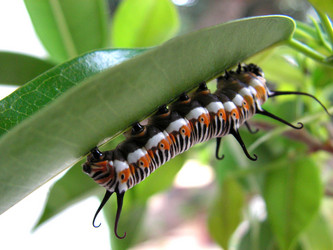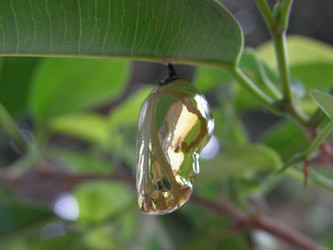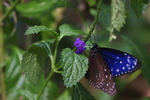Euploea
Andrew V. Z. Brower


This tree diagram shows the relationships between several groups of organisms.
The root of the current tree connects the organisms featured in this tree to their containing group and the rest of the Tree of Life. The basal branching point in the tree represents the ancestor of the other groups in the tree. This ancestor diversified over time into several descendent subgroups, which are represented as internal nodes and terminal taxa to the right.

You can click on the root to travel down the Tree of Life all the way to the root of all Life, and you can click on the names of descendent subgroups to travel up the Tree of Life all the way to individual species.
For more information on ToL tree formatting, please see Interpreting the Tree or Classification. To learn more about phylogenetic trees, please visit our Phylogenetic Biology pages.
close boxIntroduction
The genus Euploea ranges from the Comoro Islands in the Indian Ocean to the Fiji Islands, Samoa and Tahiti. Most species are medium-sized brownish butterflies with bands of marginal white spots, while some are strikingly irridescent blue/purple. Many of the larger Australasian islands are home to mimetic assemblages of Euploea spp.. Larval host plants include the families Apocynaceae, Asclepiadaceae and Moraceae.



Immatures of Euploea core corinna. Larva (left) and pupa (right). © 2005 melanie cook
Discussion of Phylogenetic Relationships
The tree shown here is based on Ackery and Vane-Wright's (1984) cladistic analysis of morphological characters, with the addition of some geographical species related to E. core elevated to specific status by Vane-Wright (1993). A few of the numerous additional generic names of Moore and others are occasionally used to designate subgenera within Euploea.
Other Names for Euploea
- Crastia
- Trepsichrois
- Salpinx
- Calliploea
- Macroploea
- Stictoploea
- Isamia
- Narmada
- Bibisana
- Andasena
- Glinama
- Danisepa
- Hirdapa
- Karadira
- Menama
- Mahintha
- Nipara
- Pademma
- Patosa
- Penoa
- Sabanosa
- Saphara
- Satanga
- Selinda
- Tabada
- Tiruna
- Tronga
- Vadebra
- Adigama
- Gamatoba
- Lontara
- Oranasma
- Sarobia
- Betanga
- Chanapa
- Chirosa
- Deragena
- Mestapra
- Pramesta
- Rasuma
- Tagata
- Nacamsa
- Vonona
- Pramasa
References
Ackery PR, and Vane-Wright RI. 1984. Milkweed butterflies. British Museum (Natural History), London.
Vane-Wright RI. 1993. Milkweed butterflies (Lepidoptera: Danainae) and conservation priorities in the Andaman and Nicobar islands, India. Butterflies, Japan (4): 21–33.
Title Illustrations

| Scientific Name | Euploea core |
|---|---|
| Location | Stanthorpe, Queensland, Australia |
| Specimen Condition | Live Specimen |
| Source | A butterfly day |
| Source Collection | Flickr |
| Image Use |
 This media file is licensed under the Creative Commons Attribution-NonCommercial License - Version 2.0. This media file is licensed under the Creative Commons Attribution-NonCommercial License - Version 2.0.
|
| Copyright | © 2007 Michael Jefferies |
| Scientific Name | Euploea mulciber barsine |
|---|---|
| Location | Taiwan |
| Specimen Condition | Live Specimen |
| Source | IMG_0281a1 |
| Source Collection | Flickr |
| Image Use |
 This media file is licensed under the Creative Commons Attribution-NonCommercial-NoDerivs License - Version 2.0. This media file is licensed under the Creative Commons Attribution-NonCommercial-NoDerivs License - Version 2.0.
|
| Copyright | © 2007 leemt2 |
About This Page

Middle Tennessee State University, Murfreesboro, Tennessee, USA
Correspondence regarding this page should be directed to Andrew V. Z. Brower at
Page copyright © 2010
 Page: Tree of Life
Euploea .
Authored by
Andrew V. Z. Brower.
The TEXT of this page is licensed under the
Creative Commons Attribution License - Version 3.0. Note that images and other media
featured on this page are each governed by their own license, and they may or may not be available
for reuse. Click on an image or a media link to access the media data window, which provides the
relevant licensing information. For the general terms and conditions of ToL material reuse and
redistribution, please see the Tree of Life Copyright
Policies.
Page: Tree of Life
Euploea .
Authored by
Andrew V. Z. Brower.
The TEXT of this page is licensed under the
Creative Commons Attribution License - Version 3.0. Note that images and other media
featured on this page are each governed by their own license, and they may or may not be available
for reuse. Click on an image or a media link to access the media data window, which provides the
relevant licensing information. For the general terms and conditions of ToL material reuse and
redistribution, please see the Tree of Life Copyright
Policies.
- First online 05 October 2006
- Content changed 21 June 2008
Citing this page:
Brower, Andrew V. Z. 2008. Euploea . Version 21 June 2008 (under construction). http://tolweb.org/Euploea/70704/2008.06.21 in The Tree of Life Web Project, http://tolweb.org/









 Go to quick links
Go to quick search
Go to navigation for this section of the ToL site
Go to detailed links for the ToL site
Go to quick links
Go to quick search
Go to navigation for this section of the ToL site
Go to detailed links for the ToL site